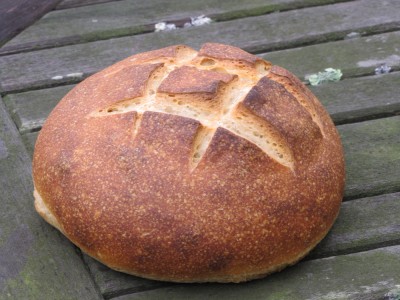adequate bread
I'm maybe starting to figure out this sourdough bread business. At least, I've settled on a process that accomplishes three key goals: it keeps the starter alive, doesn't take too much time or effort, and turns out acceptable bread.
For me, one key is not keeping the starter in the refrigerator. When I did that I could never manage the long-term scheduling required to get it out, let it warm up, feed it, and then make the bread—with all the steps that requires. It's a two-day process, minimum, and at my current stage in life that is very much beyond me. So my starter lives on the counter, where I feed it every morning with a quarter cup of water and half a cup of all purpose flour (which we buy in bulk).
When I want to make bread, I start the night before by scooping a cup of starter into a separate container and feeding it (as above) before I go to bed. Then in the morning I put all that starter into the stand mixer bowl together with 3/4 cup of water, a half tablespoon of kosher salt, and about two-and-a-half cups of bread flour. I let it mix all up with the dough hook for 20 minutes or so while I do other things (trying to remember to check to make sure it's not too wet, in which case I want to add more flour). If it's dry I knead the dough for a couple minutes by hand—if it's wet enough the machine does fine—and then I form it into a ball and leave it in a glass bowl, covered with a wet cloth.
There it stays until it's doubled in size or I get back from the day's outing or I get bored of looking at the bowl. I "punch it down" and let it rest for ten minutes, then I shape it amateurishly into a ball or, less frequently, a baguette, and leave it to proof on a heavy aluminum baking sheet greased with butter. Usually it can proof uncovered, in this summer weather at least—but if the day seems particularly dry I'll cover it with a wet cloth for at least the beginning of the proofing.
When it seems to be pretty well risen I preheat the over to 500 degrees, with a beat-up old metal 9x13 pan on the bottom rack. After 15 or 20 minutes of preheating I slash the loaf (as seen above), pour a couple cups of boiling water into the hot pan for steam, and bake for 25 minutes to half an hour. When the bread smells like bread and sounds hollow when I tap on the bottom, it's done.
Clearly, this is not the most precise of methods, and I have no doubt it's far from making the perfect loaf. But I don't care about perfect—when I worry about perfect I get paralyzed and don't make anything. Acceptable is better than nothing! There are two more pertinent problems. First, having the over on for close to an hour isn't really ideal in the summer. At least it tends to be in the evening, when it's cooler outside than in the house anyways—with windows open and fans on we don't notice the oven's heat so much.
Second, not refrigerating the starter means I have to make bread an awful lot; sometimes more often than we can manage to eat it. So I'm trying to give it away. Let me know if you'd like to try a loaf, or take some starter so you can try your hand at it yourself! If I can figure out how to make adequate bread in my spare time, I'm sure you can do even better.

comments
Note that my oven is probably 50 to 75 degrees below the temperature it thinks it is—so you should probably either reduce the temperature or time that I describe above, or at least keep a close eye on your loaf as it bakes to make sure it's not getting to brick-like.